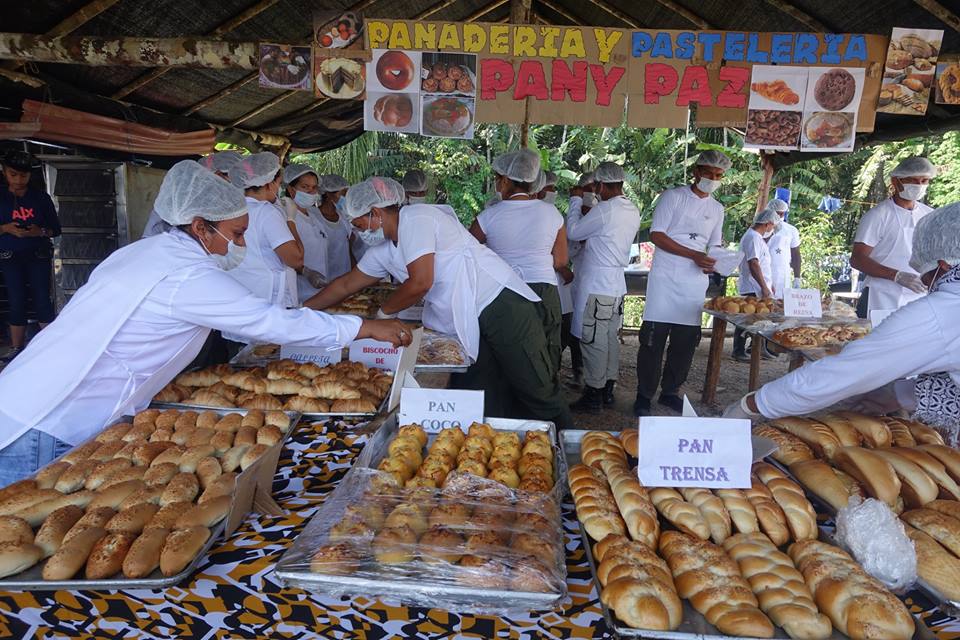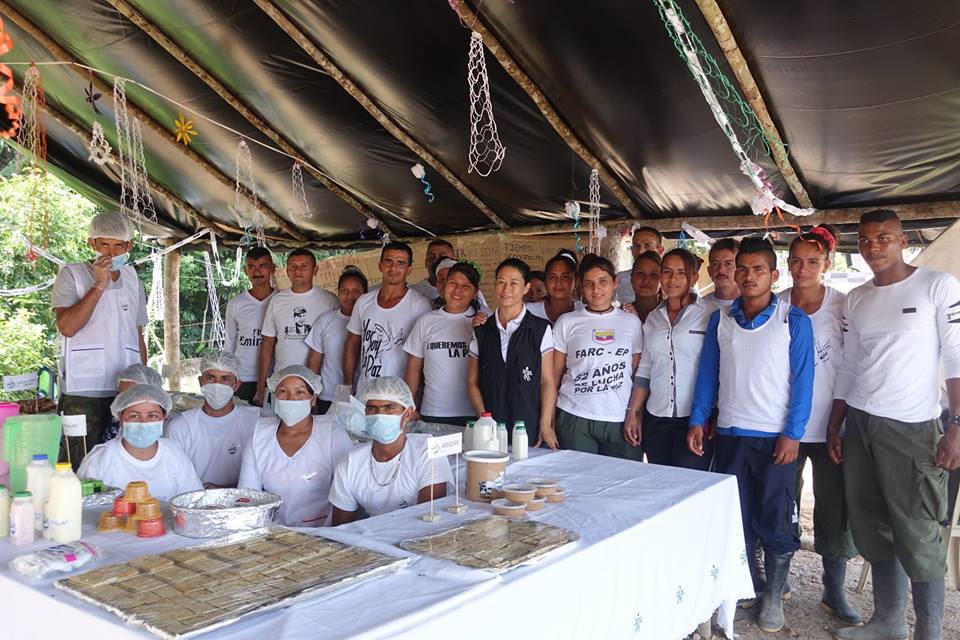Anna Vogt is the Latin America and Caribbean Regional Advocacy and Context Analyst. This post was originally published on Anna’s personal blog.
My post-accord Bogota feels about the same as pre-peace accord Bogota. My neighbours all go about their daily routines- grocery store, walk the dog, go to work- and so do I. When I have a conversation with a friend in public, even in English, we still instinctively lean in closer, lower our voices, and glance around before saying certain words. Paramilitary, FARC, ELN. You never know who might be listening….
https://www.facebook.com/100014335057550/videos/194637901024044/
But there are moments when I realize that everything has shifted. There is a video circulating around on facebook. Demobilizing FARC members, dressed in civilian clothing, dance around a circle, hands on each other’s waists. At one point, they shake their hips, at another, waddle like a penguin.. What could be more normal than Colombians, preparing to reintegrate into Colombian society, making fools of themselves, as they will do at every single dinamcia throughout the rest of their lives?

Youth in the Montes de Maria. Anna Vogt.
Part of what strikes me is also the surprising connection I feel for the uniform-free participants. In the video, the dancers look so much like every other young man and woman, in their track pants and rubber boots, that I have worked with in rural Colombia. I can imagine being part of their circle, forcing a grin on my face and putting my hands in the air as well. Afterwards, we would sit on plastic chairs under a shade tree, drinking postobon manzana and laughing at memories of each others’ moves.
- Katrina Lopez
- Katrina Lopez
In other photos, members of the FARC are featured wearing white chef aprons, complete with hair nets and mouth coverings. The technical education institute, the SENA, is teaching baking, and combatants are surrounded by loaves of different varieties of bread. The hand-cut lettering in the banner hanging in the activity gazebo reads, “Pan y Paz.” In one shot, the group of bakers pose for a group photo, the only sign of their military affiliation the buzzcuts and their white shirts, proclaiming “FARC-EP, 52 years of struggle for peace.”
The FARC is a Colombia that I know nothing about. My version of Pan y Paz are the years of Mennonite marches every Sept 21, demanding peace with social justice, bread with peace.
When I arrived in the Montes de Maria in 2011, the state had declared the zone to be FARC-free, after a period of terrible fighting between the FARC, the paramilitaries and the military. All groups committed terrible atrocities. People were finally starting to figure out how to live again in relative peace, sharing stories of ditches full of bodies and years full of terror. For me, the FARC was an armed group whose name had more power than actual presence. Despite their absence, the local authorities were still quick to accuse community leaders of belonging to the group, equating social movements with terrorism.

Anna Vogt.
During a recent team meeting we were all incredulous when a colleague shared about interactions with members of the FARC in the transitions zones. She tells us that FARC soldiers have no idea how much everyday Colombians see them as monsters. Even after fifty years of being scapegoated for everything wrong in this country, they are only now starting to gain an idea of the negativity of public perception. They are not the people’s heroes of the revolution, even if they may view themselves in that way. In fact, aside from a few facebook photos and videos, I really have very little idea of how the FARC view themselves either. Bakers or freedom fighters?

Yet in another sign of change, a feminist student group at the Javeriana invites three female FARC commanders for a public conversation. The line to enter the auditorium stretches around the campus and in the end, the flustered feminist group changes the venue location to a larger auditorium located up the hill and we walk/run up three flights of stairs, jostling one another for a seat. By the time the students are ready to moderate the conversation, they stumble through sentences and timing, but the three FARC women appear delighted to be in public, even if their audience is mainly students and a few NGO folk.
For all of us, this is a new experience. Just a few years ago, appearing in public would have been impossible: the three commanders targets for attack and the rest of us for arrest and deportation. Instead, we sit and listen as Victoria Sandina, Isabela Sanroque,and Antonia Narino share about their lives within the FARC, their visions of feminism, and their plans to be involved in politics in the rural areas where they are demobilizing. They talk about equality, the fight against poverty and how as women, they will be part of shaping Colombia. I am struck by how little I understand their world, and how little they seem to grasp mine. An air of the unbelievable surrounded the entire evening, from the student group in charge of organization to the very different Colombia we are at once confronted with, out of the jungle and in the city.

Anna Vogt.
None of us are quite prepared for this encounter with the other. The negotiating is done, the papers are signed, but we have no idea how to integrate transition zone Pan y Paz into the Anabaptist version, nor how to broaden our understanding of what being a Colombian could and does mean.
We, as in all the women in Justapaz, are declaring ourselves as conscientious objectors in time for the International Day of Conscientious Objection on May 15th. The communications staff in our office bounce from woman to woman, asking when they can record a short video of our declarations as COs, and invite our female friends to do the same. Justapaz wants to recognize the behind the scenes work of mothers and sisters, community leaders and aunts, in encouraging their sons and relatives’ resistance to obligatory military service. The idea is that women build peace everyday by creating alternatives to war, within their families and their workplaces. Women also refuse, in the tradition of Carlota Rúa, the first Colombian to protest mandatory enlistment during the war with Peru in 1927, to give “one more son to war,” and in that way also object to military service. In making these videos, however, what kind of an image of women as natural peacemakers are we presenting?

Anna Vogt.
In Colombia, women don’t go to war. That is, women don’t perform obligatory military service. They go to war alright. As the previously hidden world of the FARC, opens up, a new understanding of women as combatants is slowly being revealed. To our surprise, we hear that Isabela Sanroque of the FARC has presented her own message, also asking women to declare themselves as COs.
Looking at the FARC dance in the video, I realize that part of my problem is seeing past the uniform to the person. Without the camouflage, I can connect the soldiers to the youth telling jokes in front of the Mampujan store. Because I do hear the discourse often, and see the flags and banners proclaiming the courage of Colombia’s chosen sons everytime I go down the 26, I have stopped listening with curiosity to the military. Yet behind each and every soldier, there is also a person with a vision of their country and themselves.

Barges and warships docked on the Putumayo River. Anna Vogt.
Understanding those visions is a step in the right direction towards peaceful coexistence, yet it must involve seeing past our stereotypes of who we are and who the other is. We have only begun the most challenging work of all.
In book club, we sit a table heaped with French toast, coffee in hand, discussing readings about demobilization efforts and the way that women FARC combatants force us to ask questions about our ideas of gender in Colombia. Women are not always the peacemakers, but military commanders can also question the idea of forced battle. Somehow, as we talk about gender dynamics and reincorporation, we have to start questioning our essentialized ideas about each other, whether pacifist or soldier, man or woman.
Looking at the FARC dance in the video, I realize that part of my problem is seeing past the uniform to the person. Without the camouflage, I can connect the soldiers to the youth telling jokes in front of the Mampujan store. Because I do hear the discourse often, and see the flags and banners proclaiming the courage of Colombia’s chosen sons everytime I go down the 26, I have stopped listening with curiosity to the military. Yet behind each and every soldier, there is also a person with a vision of their country and themselves.
Understanding those visions is a step in the right direction towards peaceful coexistence, yet it must involve seeing past our stereotypes of who we are and who the other is. We have only begun the most challenging work of all.


